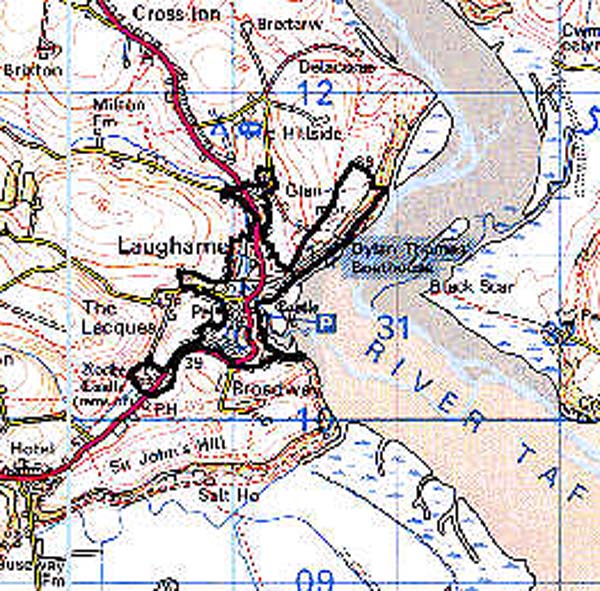|
Home > Historic Landscape Characterisation > Carmarthen Bay Estuary Area > |
 LAUGHARNE TOWN AND BROADWAY
LAUGHARNE TOWN AND BROADWAY 
GRID REFERENCE: SN 301108
AREA IN HECTARES: 51.10
Historic Background
Laugharne is a small town and medieval borough in which there has been considerable survival of historic features. An Early Christian Monument and a possible long cist cemetery suggest a pre-Norman foundation for St Martin's church at Laugharne (Ludlow 1998). However, it was the foundation of an Anglo-Norman castle by 1170 that led to the development of a town at Laugharne. A settlement probably grew outside the castle soon after its foundation, and around the small inlet which became a port. In 1278-82, Laugharne was granted borough status and lands were bestowed on it by Sir Guy de Brian (Williams, n.d.). Topography and later documentary evidence indicates that the early town of just over 30 dwellings was walled, and that the settlement quickly expanded outside the these walls (Murphy, 1987). A later licence to wall the town, of 1465 (Delaney and Soulsby, 1975; Soulsby 1983) does not seem to have been acted on. The late Medieval farmstead or manor-house of Roche Castle lying to the west of Laugharne was tenurially distinct from the borough. Laugharne seems to have been a fairly successful small town throughout the Medieval period, and by 1595 over 161 burgage plots were recorded (Laugharne Corporation). Although this number of plots seems to have remained fairly constant through to the mid 19th-century, important changes had by then taken place, as recorded by Mary Curtis (1880). In the latter part of the 19th century Laugharne became a fashionable 'resort' town. Many of the modest dwellings of an earlier period were rebuilt in the fashion of the day. By the mid 19th-century the town lost both its fashionable status, and the remnants of its coastal trade, and suffered stagnation and decline. Since the Second World War a small housing estate has been built outside the core of the historic town. In recent years many of the older properties have been renovated and new houses in a variety of styles and materials constructed within the historic core and on the outskirts. Broadway, a 'suburb' to the southwest of the town, has witnessed much recent development. A holiday complex has been built at Glan-y-môr to the east of the town, and a caravan park to the north.
Base map reproduced from the OS map with the permission
of Ordnance Survey on behalf of The Controller of Her Majesty's Stationery
Office, © Crown Copyright 2001.
All rights reserved. Unauthorised reproduction infringes Crown Copyright
and may lead to prosecution or civil proceedings. Licence Number: GD272221
 Description and essential historic landscape components
Description and essential historic landscape components
The small town of Laugharne centres on the Medieval castle. This structure dominates the foreshore and the town. One of the key characteristics of the town are the elegant stone-built and stucco 18th- and 19th-century buildings that flank King Street, culminating in the town hall and Castle House. Houses on other streets tend to be less imposing, but nevertheless stone-built cottages and terraces of small houses, usually rendered and colour-washed, with slate gable roofs provide a uniformity of style. Within the historic core more recent housing has been low-key in character, and consists of single dwellings or small estates. Larger developments comprise an estate of council houses overlooking the town to the south with a school adjacent, and a cluster of dwellings in a variety of styles and materials at Broadway. St Martin's church, a cruciform structure of the mid-15th century, lies to the north of the town with a loose cluster of mainly 19th century housing. 20th century linear development connects this area with the main town. Tourist industry development consists of a large holiday complex of chalets at Glan-y-môr, a caravan park at Ants Hill and less intrusive works associated with Dylan Thomas's Boathouse and Laugharne Castle.
Recorded archaeology within the town mainly represents its Medieval history - the castle, church, town walls and mill site, and its Post-Medieval domestic structures. However, there is an Iron Age enclosure at Glan-y-môr, while the Early Christian Monument and cist cemetery at the church have been noted. There was little Post-Medieval industry but there is a lime-kiln on the foreshore and a smithy at Broadway. The late Medieval farmstead at Roche Castle has an associated Post-Medieval cockpit.
The distinctive nature of many of Laugharne's buildings has been noted. In addition to the castle, which is a Scheduled Ancient Monument and comprises two Grade I listed buildings and a Grade II listed building. There are a further 51 listed buildings, all Grade II or II*; they are primarily 18th century and domestic, and include the town hall, but also the Medieval church.
